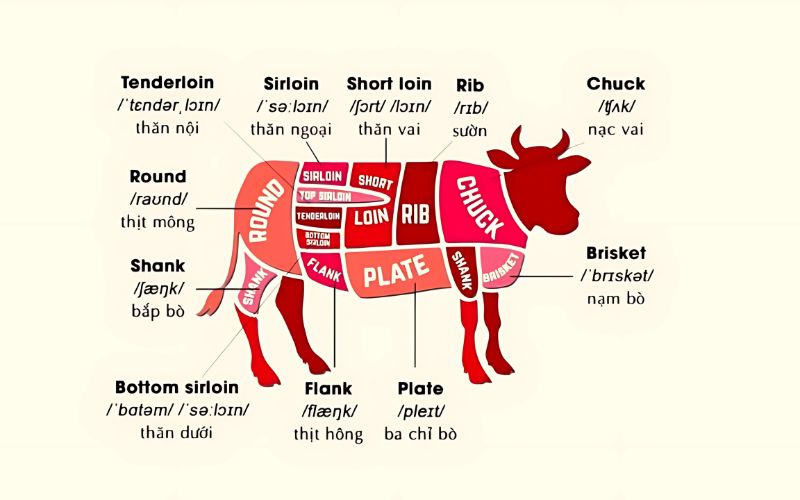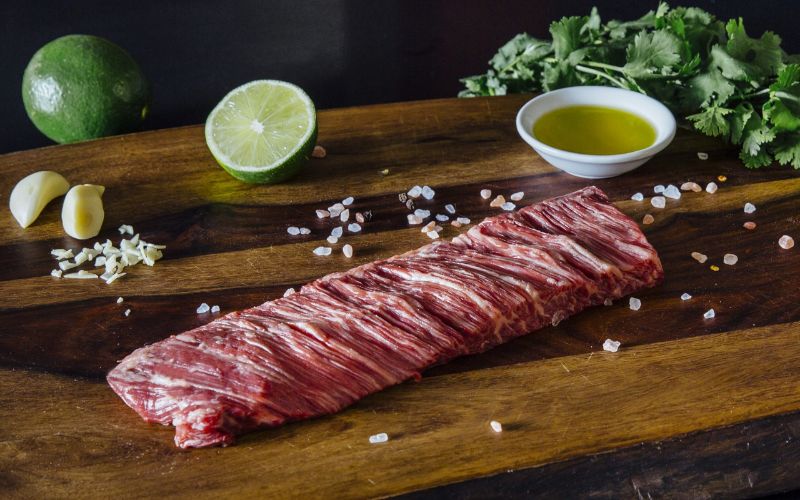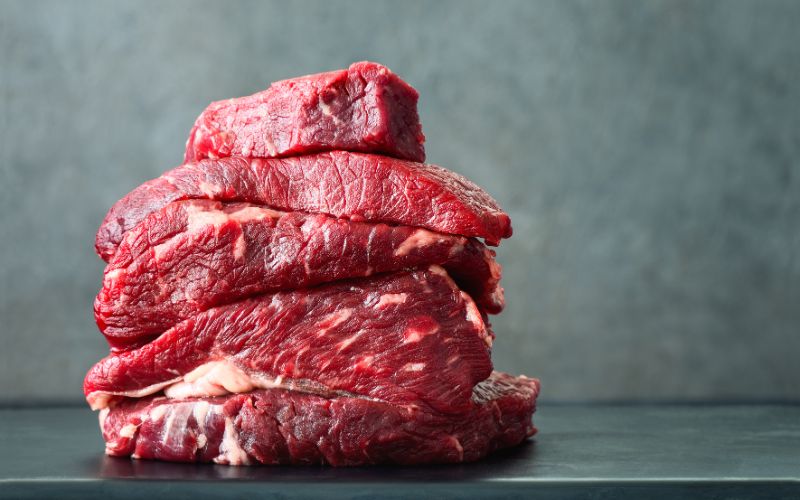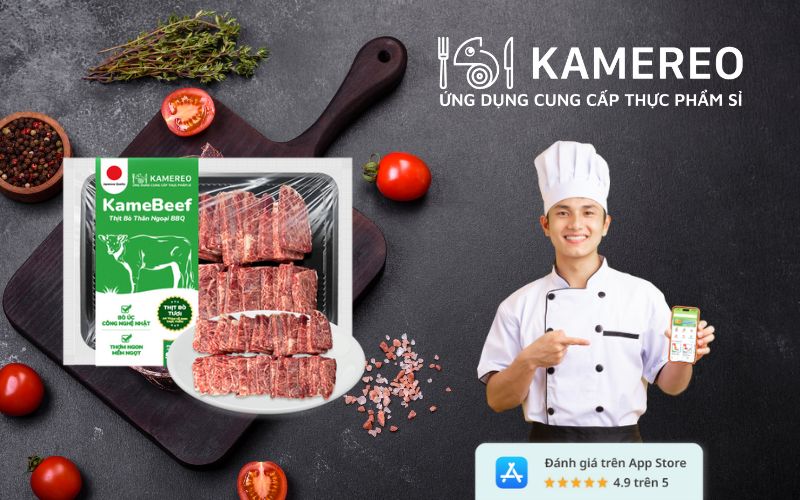What is beef tenderloin? It’s the cut of meat located from the middle of the cow’s belly to near its rump. Beef tenderloin is soft, low in fat, rich in flavor, and commonly used for steaks, grilling, or pan-searing. Besides being delicious, beef tenderloin also contains many nutrients beneficial for health. So, how many types of beef tenderloin are there, and how do you choose the best one? Refer to Kamereo’s article below for more useful, detailed information.
What is Beef Tenderloin?
Beef tenderloin is the cut of meat located from the middle of the cow’s belly to near its rump. This cut is particularly lean and low in fat, yet it retains its softness and delicious flavor. When prepared correctly, beef tenderloin has a melt-in-your-mouth texture, is juicy, and doesn’t dry out even without much fat, making it suitable for grilling, pan-searing, or high-end steaks.
Beef tenderloin is often sold at a high price because of its high value in both nutrition and flavor. With an abundant protein ratio, beef tenderloin is easily metabolized and absorbed by the body, supporting muscle recovery and development, while also providing energy for athletes.
Beef tenderloin is also rich in phosphorus, which helps improve bone and teeth quality, and reduces the risk of osteoporosis. Additionally, beef tenderloin contains many important B vitamins such as B3, B6, and B12, supporting blood formation function and improving anemia, especially in women and those recovering from illness.

Types of Beef Tenderloin
Although all belong to the tenderloin group, each part has distinct characteristics regarding its location, texture, and tenderness, suitable for different cooking methods. Below are common types of beef tenderloin you can refer to:

Beef Outside Skirt
Beef outside skirt, also known as diaphragm or hanger steak, is a strip of meat located in the lower belly region of the cow. Outside skirt has meat accompanied by a lot of marbling, giving it a sweet, tender, slightly chewy, and crispy taste. Compared to other parts of the belly, outside skirt is highly valued for its flavor. Although slightly tough due to many tendons, when grilled, pan-seared, or hot-potted correctly, beef outside skirt becomes exceptionally tender and delicious.
Sirloin
Sirloin is located near the back, and this cut has both high leanness and thin fat marbling interspersed, which helps retain moisture and enhance flavor when cooked. This cut is often used for steaks or grilling due to its moderate tenderness and attractive richness, suitable for many diners’ palates.
Tenderloin
Also known as beef fillet, the tenderloin is located between the short loin, sirloin, and top sirloin. This is the softest part of the cow’s body, with each cow yielding only about 2kg of tenderloin. With a fine meat structure and few tendons, tenderloin is particularly suitable for pan-searing and high-end steaks, providing a refined culinary experience.
Short Loin
Short loin is the cut of meat located in the mid-back, separated from the beef shoulder, and contains no cartilage or bone. The short loin usually has a layer of fat on the outside, creating natural tenderness and richness when cooked. This is an ideal cut for fillets, thinly sliced pan-searing, or quick grilling.
How to Cook Delicious Beef Tenderloin
To achieve a perfectly delicious beef tenderloin dish, proper preparation and cooking are crucial. Here are detailed steps to help you create appealing dishes from beef tenderloin:
Step 1: Remove Tendons
Beef tenderloin often has quite tough tendons, which, if left in, will make the dish difficult to tenderize and take a long time to cook through (possibly over 3 hours).
To remove tendons, use a boning knife to make shallow cuts along the muscle fibers, then carefully remove the tendons. Next, use a knife to trim away any silver-colored parts on the meat to ensure uniform tenderness.
Step 2: Cut the Meat
You should cut the meat into pieces 2.5-5cm in size for quick and even cooking. If you want to keep larger pieces, ensure the meat cooks evenly from the inside out. Before cooking, you should use paper towels to pat the surface of the meat dry to help it achieve the desired crispiness when cooked.
Step 3: Marinate the Meat
You can marinate beef tenderloin with a little pepper and gently rub garlic on the surface to enhance the flavor without losing the meat’s natural taste. Another option is to coat the meat with a tablespoon of olive oil or butter, then sprinkle salt and pepper evenly.
Note: When marinating meat, you should use a stainless steel or glass container and avoid marinating for more than 24 hours to ensure the best meat quality.
Step 4: Cook the Tenderloin
After preparing and marinating, you can pan-fry, grill, or pan-sear the beef tenderloin to make a steak. To ensure even cooking, turn the meat every minute. The cooking time will depend on the thickness of the beef and your desired doneness.

Tips for Choosing Good Beef Tenderloin
To buy quality beef tenderloin, you need to pay attention not only to the place of purchase and color but also to the feel and smell of the meat:
- Good beef tenderloin has a bright red color, feels soft to the touch, has good elasticity, and is not sticky. When lightly pressed, the meat immediately springs back.
- Avoid choosing meat that is pale blue, has unusual white spots in the muscle fibers, or has a foul odor.
- Avoid pieces of meat with dark yellow fat, yellow bones, or that are mushy; these are signs that the meat is no longer fresh.
- Buy meat from a reputable store with clear origin certification, specializing in importing beef and storing it according to standards.

Kamebeef – Fresh, Delicious Australian Sirloin, Good Price for F&B Businesses
If you’re looking to purchase beef tenderloin for your F&B business, KameBeef sirloin is an ideal choice you can’t miss. KameBeef is a premium Australian sirloin product, featuring natural marbling. The meat has a tender, juicy texture and a rich, sweet flavor.
Buy KameBeef Sirloin at Kamereo:

Frozen Kame Beef Striploin Steak 200g
99,000đ/PACK

Frozen Kame Beef Striploin BBQ Slices 500g
239,000đ/PACK

Frozen Kame Beef Striploin Stir-Fry Cubes 200g
99,000đ/PACK
KameBeef applies advanced Japanese fat distribution technology, which helps distribute fat evenly throughout each muscle fiber, creating a rich and melt-in-your-mouth sensation like Kobe beef. However, the price of KameBeef sirloin is very reasonable, suitable for restaurants and eateries that need high-quality ingredients while optimizing costs.

You can buy premium Australian sirloin at Kamereo at a great price. Stored and transported according to strict procedures, every piece of KameBeef sirloin that reaches you is guaranteed to be fresh and delicious.
With the Kamereo wholesale food supply application, you not only get good and stable prices but also a fast delivery system and strict quality control. Importantly, the smart application platform makes it easy to order, track costs, manage multiple branches, and generate transparent reports – all with a single supplier.
Order Kamebeef sirloin at Kamereo now to elevate your menu, optimize operations, and ensure a constant supply of ingredients!
Conclusion
We hope the information above has helped you better understand what beef tenderloin is, its classifications, how to prepare it, and tips for choosing the best cut to create delicious and flavorful dishes. Additionally, you can discover more unique recipes and interesting culinary tips in our Food and Lifestyle section.



